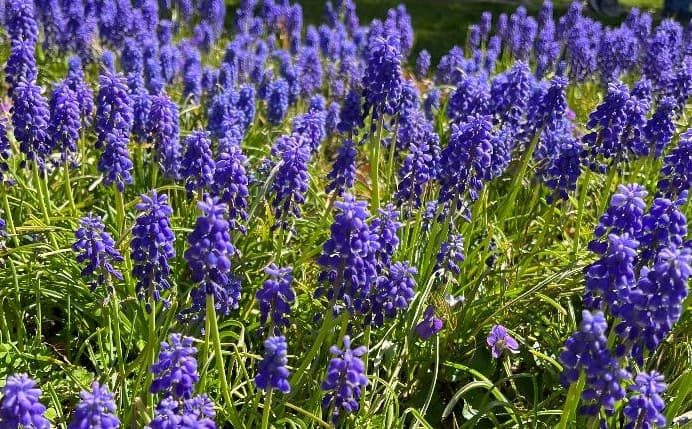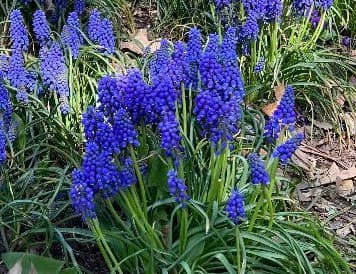How to Grow and Care for Muscari Flowers, Grape Hyacinth

About Growing Muscari Flowers in Your Home Flower Garden
Muscari flowers are a popular spring-flowering bulb. This wee little bulb puts on a big, bold show in early spring. Commonly called Grape Hyacinth, it is a member of the Lily family. There are 30 species. Muscari plants are native to central Europe and the Mediterranean, as well as central and western Asia. They are commonly found around woodlands and pine forests. The plants grow well in your sunny flower gardens Growing Muscari rewards you with bright, attractive flowers and a light, pleasant scent. Without getting a close-up, it may be hard to smell them when planted singly.
Muscari plants grow just 6 to 9 inches tall. The spherical, spiked flowers grow atop thin, blade-like green, grass-like foliage. This fall-planted bulb will produce foliage in the fall, that will withstand harsh winters, making it ready to bloom shortly after the snow recedes. The flowers are long-blooming. They last 3-4 weeks.
Other Names: Grape Hyacinth, Starch Hyacinths, Tassel, Bluebells
Muscari looks best grown en masse in groups of a dozen or more. They will look great, placed almost anywhere. Try growing Muscari in rock gardens and around trees and shrubs. These plants can be invasive. Use border edging, if you want to limit their spread. They look nice in containers on your balcony or deck. Also, you can force them to bloom indoors in the winter months, where their bright color will add cheeriness to your home.
Muscari are deer-resistant. The deer do not like the sweet, musky scent.
Flowers Bloom: Late Spring to Summer
Flower Colors: Varying shades of blue, lavender, pink, purple, red, white, and yellow.
Plant height: 6 to 9 inches tall, and 3 to 6 inches wide.
Plant Hardiness Zones: 4 – 8
Perennial, Asparagaceae

Muscari Flower Plant Propagation
Grape Hyacinths are commonly grown from bulbs. Plant the bulbs in Autumn. They look their best when planted ingroups of 25 or more.
Muscari can also be propagated from seeds. It has a long, 6 – 8 week germination period. Sow seeds in late spring or early summer. Next, cover them very thinly with fine, light garden soil. Then, cover the planting area with a glass or some plastic. Keep the soil moist. Seed started plants will be ready to transplant in the fall.
Bulb Planting Depth: Plant the small bulbs 2 to 4 inches deep.
Final Plant Spacing: Space plants 2 to 3 inches apart. They tolerate a little crowding. However, plants and flowers are smaller when overcrowded.
How to Grow Muscari Flowers
Select a location that receives full to partial sun.
Muscari plants grow well in average, well-draining soil. We always recommend adding compost, before planting.
The plants should not require additional fertilizer, except in the poorest of soils.
During the growing period, keep the soil moist, not dry or wet. The tiny bulbs can dry out easily. So, make sure to water them during the growing period, as needed. But, also keep in mind that they do not like soggy soil.
Plant new bulbs in the fall, in a location where they will not be disturbed for many years. Plant bulbs three inches deep. Space plants about 3 inches apart. The bulbs will fairly quickly produce hardy leaves, that will survive a harsh winter.
Use border edging on these invasive plants, if you want to limit their spread.
The plants usually do not need pruning. The leaves will naturally die back several weeks after blooming. After blooming, the leaves send energy to store in the bulb for the next season. So, do not cut the plant back to the ground until it dies back naturally.
After the flowers bloom, continue to provide water, as needed, until the plant dies back.
By early summer, the plants die back, and the bulb goes dormant until fall when it again produces a new set of leaves. Once the plant has died off, you can cut the dead leaves at ground level.
Mulch around plants in the fall with compost or well-rotted manure.
To maintain plant vigor and bigger blooms, dig up and divide every three or years. When you do, don’t forget to give some to your gardening friends!
Ideal Soil pH: 6.0 – 7.0.
Growing Muscari Plants Indoors
Like many other bulbs, Muscari bulbs need a dormant, chilling period to set the blooms. In nature, the cold winter provides this “chilling period”. The bulbs need to chill for 10-12 weeks. This can be accomplished by putting corms in the refrigerator. Another way is to pot them up and set the pots out in a cold garage.
Once the chilling period is complete, bring the pots with the muscari bulbs indoors and bring them up to room temperature overnight. Then add water to the container and you are on your way to seeing bright and cheerful freesias in the dead of winter.
After the plants have bloomed and died back, you can dig the corms out of the pot, and store them for planting outdoors in the Fall.
Note: Often crocus grown indoors will not store a sufficient amount of energy to bloom next year. However, with a year of growth outdoors, they will bloom again the following year.
Insects and Plant Disease
Muscari seldom has insect or plant disease problems.
Spider mites are an occasional pest problem. Use insecticidal soap to eliminate them.
Yellow mosaic virus can occur. It is not curable and the plant will not survive. Remove and destroy any affected plants and bulbs.
Some people wonder if drooping leaves are a sign of insect or disease problems. It is not. Rather, drooping muscari leaves are the result of insufficient sunlight.
Related Articles
Also, people who read this article will like:
Flower Gallery – Find pictures of your favorite flowers.
Flower Bulbs for Sale – And, remember to buy extra for growing indoors in the winter.
Please support our site. Shop for:
- rmmatthews100@hotmail.com
- 585-721-6528
- Rochester, NY
©1999-2024 GardenersNet.Com, All Rights Reserved

